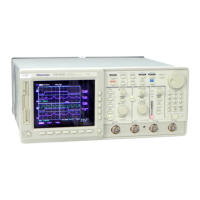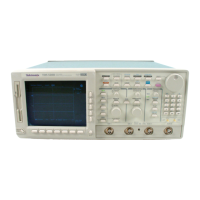Typical Characteristics
2–30
TDS 500C, TDS 600B & TDS 700C Performance Verification and Specifications
Table 2–17: Typical characteristics — Triggering system (cont.)
Name Description
5
The minimum signal levels required for stable runt pulse triggering of an acquisition. Also, see the footnote for Sensitivity,
Edge-Type Trigger, DC Coupled in this table. (Stable counting of events is counting that misses no events).
6
The minimum signal levels required for stable pulse width or glitch triggering of an acquisition. Also, see the footnote for
Sensitivity, Edge-Type Trigger, DC Coupled in this table. (Stable counting of events is counting that misses no events).
7
For Logic, time between channels refers to the length of time a logic state derived from more than one channel must exist
to be recognized. For Events, the time is the minimum time between a main and delayed event that will be recognized if
more than one channel is used.
8
For Slew Rate Triggering, this is the minimum transition time, defined to be the time the user’s signal spends between the
two trigger threshold settings.
9
User Hold Time is the number selected by the user in the Hold Time Menu.

